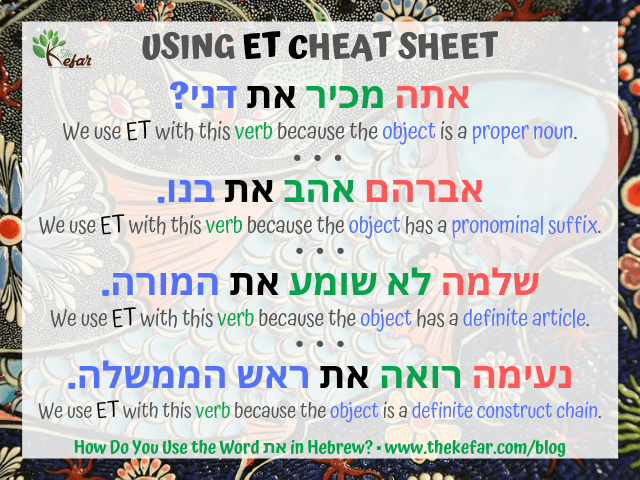The Hebrew word אֶת – pronounced /et/ – doesn’t have a translation in English, and that makes it one of the more difficult grammar points for Hebrew learners. It’s a major part of Hebrew speech, though – you can’t learn Hebrew without learning how to use את. So what is it for? When do we use it? Read on to find out, and you can also check out the 60-second Hebrew video version below.
ET is a preposition that serves as a definite direct object marker.
That’s a lot of grammar mumbo jumbo, I know – let’s break it down.
A preposition shows a relationship between a pronoun or noun, and another word in a sentence. For example:
- The train is on the track. (noun, preposition that shows its relationship to another word)
- She crawled under a table. (pronoun, preposition that shows its relationship to another word)
In a sentence, you have a subject, a verb, and an object. The verb is the action, the subject is doing or performing the action, and the object is the recipient of that action.
For instance:
- I love you – love is the verb; “I” is the subject (I love); “you” is the object (you are being loved).
- She saw a car approaching – “saw” is the verb; “she” is the subject (she saw); “car” is the object (the car was seen)
A direct object is an object (a noun) in a sentence that:
- is preceded by the definite article the (i.e. the song);
- is a proper noun (i.e. Brooklyn, Eli);
- has a pronominal suffix (i.e. yadi [ידי] “my hand;” be’no [בנו] “his son”); or
- is a definite construct chain (i.e. chofesh hadibur [חופש הדיבור] “the freedom of speech”
ET (את) marks the definite direct object of a sentence.
For example:
- She saw the car approaching – היא ראתה את המכונית מתקרבת – Here we have an את, because the object (the car) is definite.
- She saw a car approaching – היא ראתה מכונית מתקרבת – No את, because the object (a car) is not definite.
See the image below for more examples of when to use את in a Hebrew sentence.

It’s very important to note that not all Hebrew verbs are followed by the preposition אֶת, even when the sentence does have a definite direct article. Many other Hebrew verbs require different prepositions. Pay careful attention to what preposition follows a Hebrew verb that you hear or read, and you will start to pick up on what prepositions you need to use with what verb.
Some of the most common Hebrew verbs that do require an את (when all the conditions are met) are as follows:
- לראות – lir’ot – to see
- לרצות – lirtsot – to want
- לאהוב – leehov – to love
- לאכול – leechol – to eat
- לעשות – laasot – to do, make
- לקרוא – liqro – to read, call, name
- לשמוע – lishmoa – to hear
What other Hebrew words are you unsure of how to use? Let me know in the comments!


Thank you, thank you, thank you!!! I’ve never seen an explanation before and Duolingo doesn’t explain any rules. First time on your site and I’m liking it!
excellent video. where may I find the longer explanation of et?
https://www.youtube.com/watch?v=3nXGHasLtfo
Excellent explanation. Your video is also very good
Thanks Parimala!
By far, the best explanation ever. Thank you.
You are such a great language teacher that you have very good skill in explaining grammatical things clearly. I love your lively presentation as well as your good voice. 😊
Iam so grateful to you Mam . your lesion is very useful and easy to grasp. THanks
Thank you!
Hi,
I was reading Genesis 4:1 and noted that a slight ‘discrepancy’ in many English translation. (I read basic beginner’s Hebrew).
Anyway, I saw the ‘את’ in the sentence and started wondering how is it used and what is it importance.
Your explanation shed a huge light into my understanding.
Thank your very much for your extended expansion.
Keoagile
A few years later, your article and your video continues to be watched! I loved it. You clearly explained what ‘et’ is and how to use ‘et.’ The example of ‘Jonah ate the fish’ was perfect.
I get excited whenever I can exclaim, “Oh, I get it now!” You’ve made my day.
What a wonderful way to start 2025 🙂 thanks, Ellen! Glad I could help.